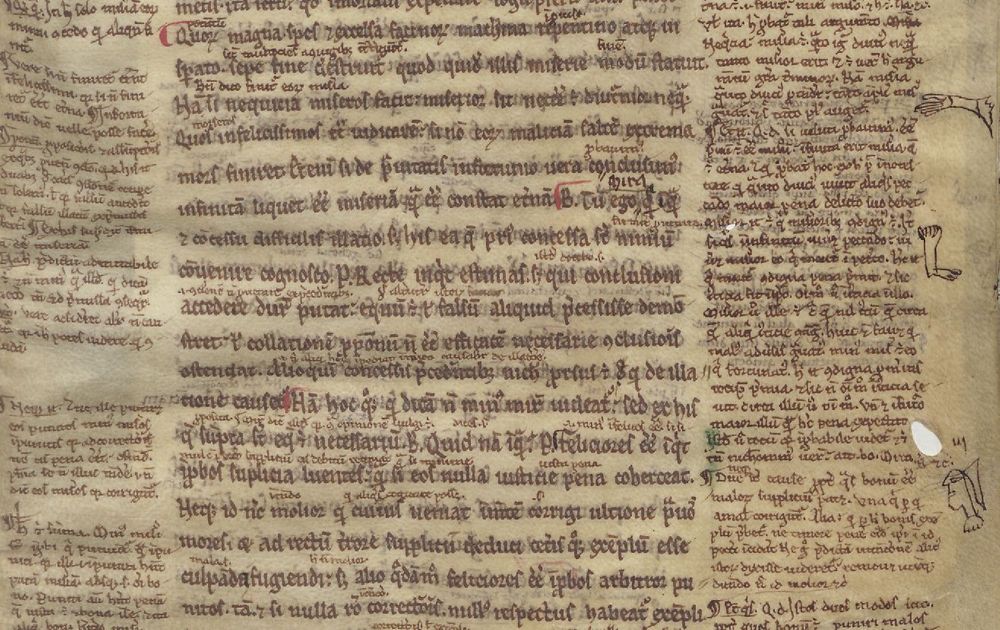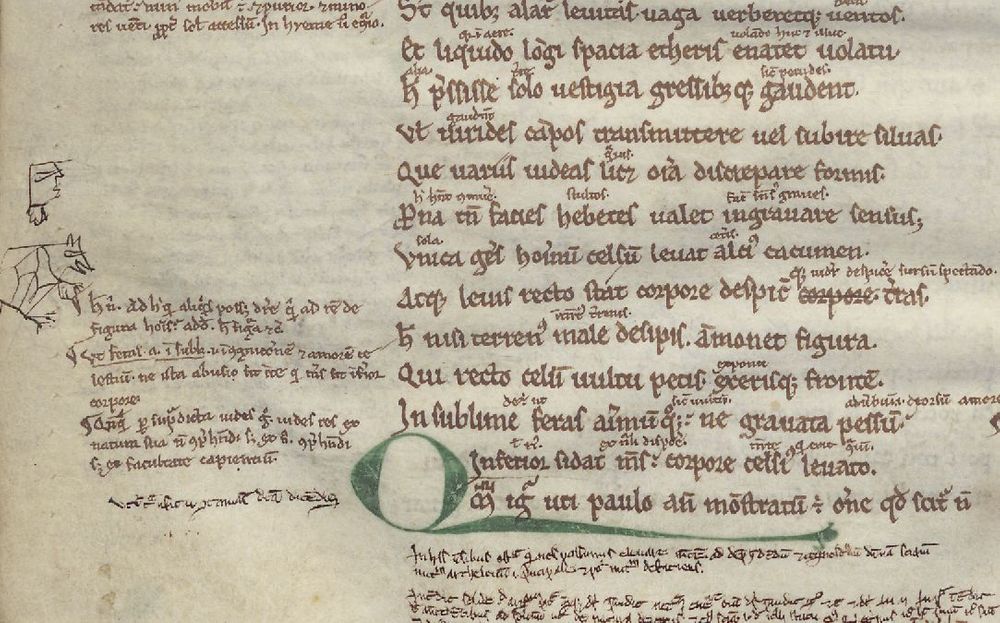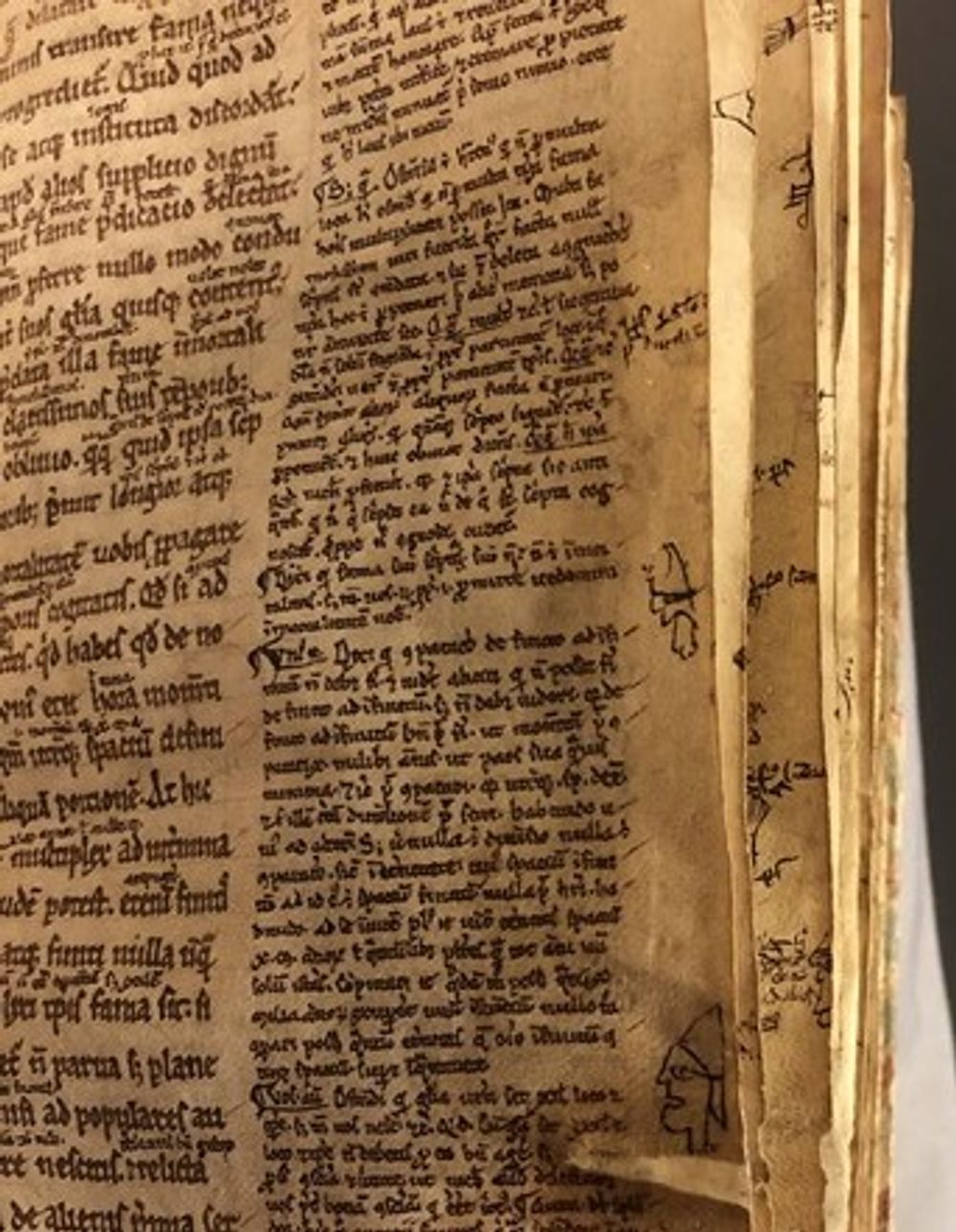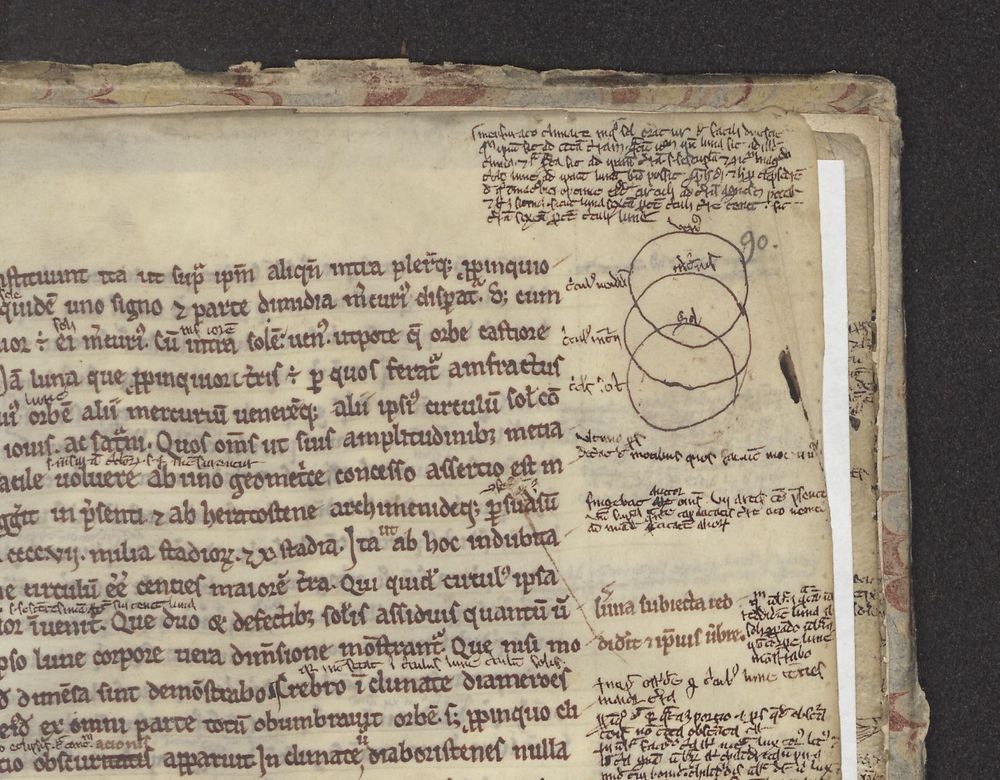Leiden, UB, BPL 144
Boethius and Martianus: to educate and entertain1
The texts in this codex illustrate the arts of grammar, rhetoric and dialectic in practice rather than in theory: two authors, Boethius and Martianus, present rich stories in a mix of prose and poetry, engaging with many of the principles of rhetoric and dialectic in their text. In the Consolation of Philosophy, lady Philosophy argues with the author himself, Boethius, about the value and meaning of life when he has fallen on bad times. In Martianus’ De nuptiis, the story of Mercury’s marriage with Lady Philology shows how all the liberal arts contribute to an ultimate knowing of the universe. In this manuscript, wide margins are provided to allow ample commentary: a space for them has been marked off by vertical lines on either side of the text. A first, contemporary set of commentary texts have been copied in the prepared space around the text. In addition a second, later layer (last quarter of the thirteenth century) has interacted with the text in a very lively and personal way, adding notes, drawings and peculiar attention signs.
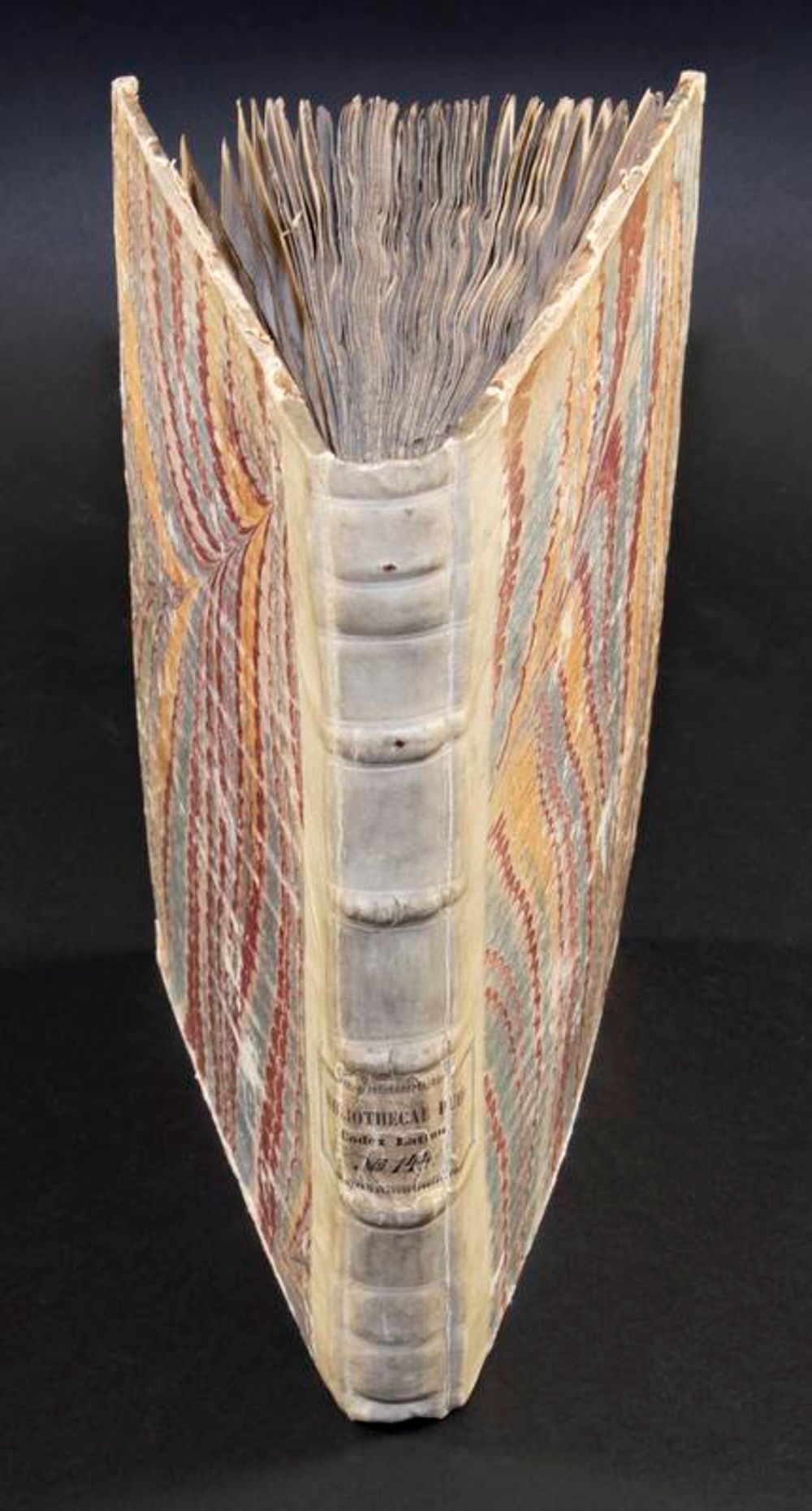
http://hdl.handle.net/1887.1/item:2356986
On this opening, we see some preliminary material on the left (fol. 1v), and the beginning of Boethius’ Consolation of Philosophy (fol. 2r) on the right. This work, which was written part in poetry (opening lines on this page), part in prose (last six lines on this page) was very popular in medieval schools. It had both beautiful poetry and prose and appropriate moral lessons. It could thus be used both for the teaching of Latin grammar and style and for moral education and philosophy. That the text was used for education, is clear from the lay-out of the page, which allows a large marginal space for commentary (70% of the page!). Notes could also be added between the lines for a more detailed explanation of words, their grammatical form and their meaning.
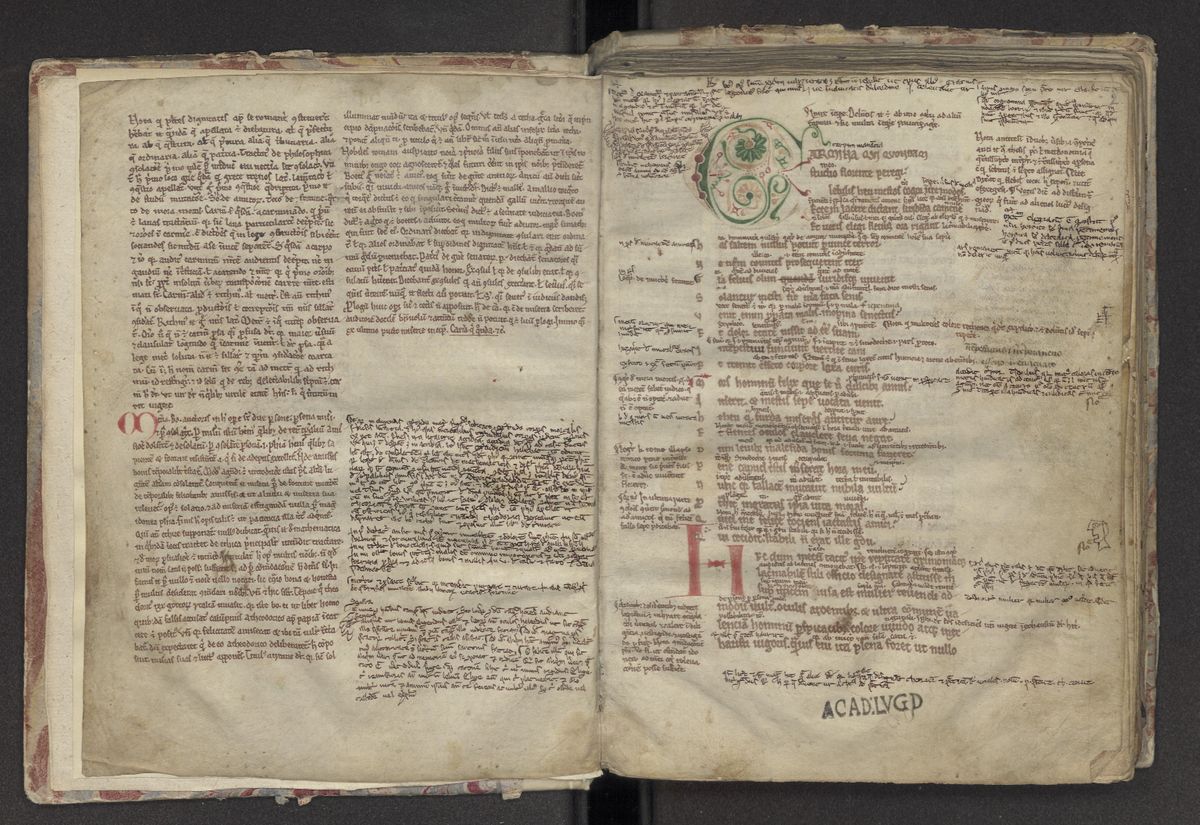

By looking closely at this page from the Martianus Capella part of the manuscript (fol. 66v), one can see how a full grid of ruled lines was provided to write the dense lines of commentary. In the ruling pattern, one line of text equalled two lines of commentary. The ruling lines were created with a sharp point: a pattern of indented/ridged lines is the result.

http://hdl.handle.net/1887.1/item:2356986
Zooming in on this first page of the Boethius part of the manuscript (fol. 2r), we see the ample space in between the lines to accommodate glosses. Interlinear glosses and marginal notes have been added to the text in a hand that matches the hand of the text. These can be dated to the last quarter of the twelfth century (indicated here with the red boxes added by us). A second set of notes has also been added to the text. The type of script used in these suggests that they were written in the last quarter of the thirteenth century (indicated here by the blue boxes).
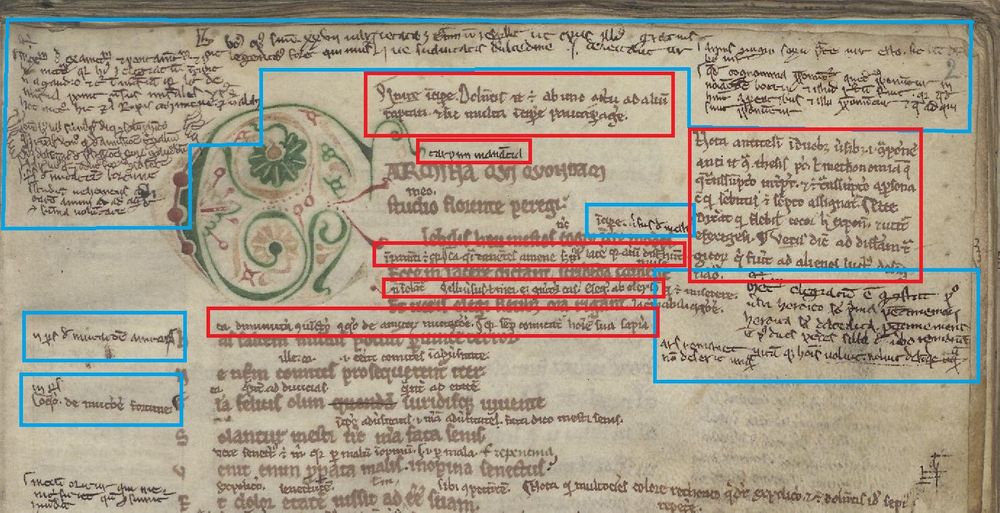
http://hdl.handle.net/1887.1/item:2356986
The second, thirteenth-century annotator shows his personality through his annotations: he uses faces, pointing hands, and fanciful creatures to draw attention to particular places on the page. He also adds little sketches such as here on fol. 10r: a ‘Wheel of Fortune’. It illustrates the famous description of Boethius of the inevitable cycle of men’s rise to fame and downfall, from the top to the bottom and up again (Boethius, Consolation of Philosophy, Book 2, Chapter 1).
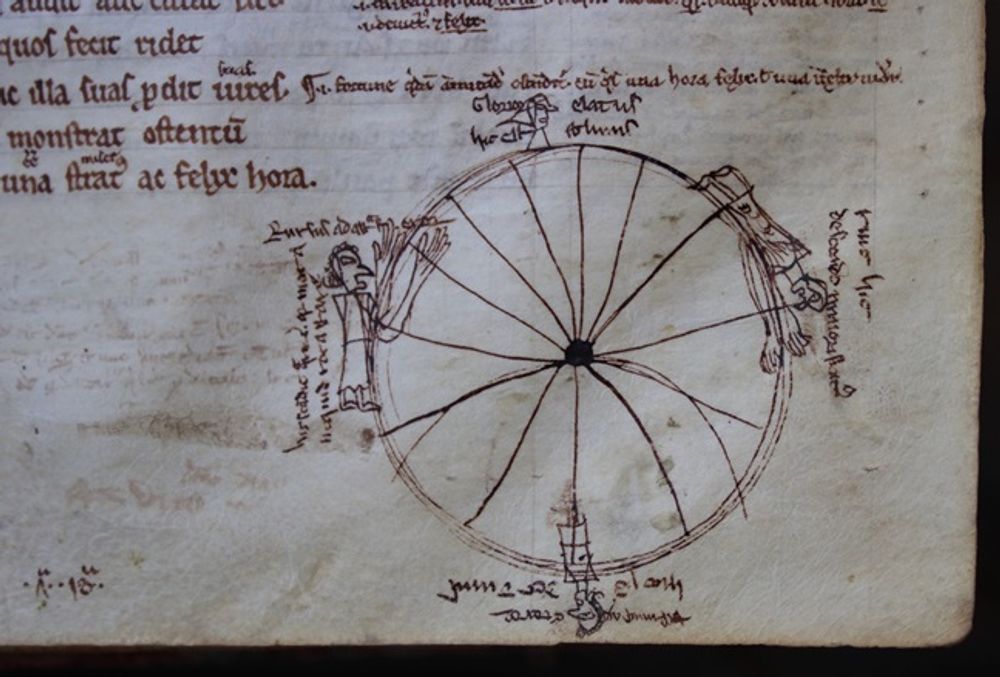
http://hdl.handle.net/1887.1/item:2356986
Note that the two hands even have different ways of calling attention to certain elements in the text: they both use ‘Nota’ to signal important elements in the text, but in the original layer, the ‘Nota’ is written in a different way. Sometimes it is not written at all, but replaced with a head, a pointing hand or even a foot (?). Note, too, that on multiple occasions, the two readers agree on what is noteworthy in the text. Their markings frequently overlap.
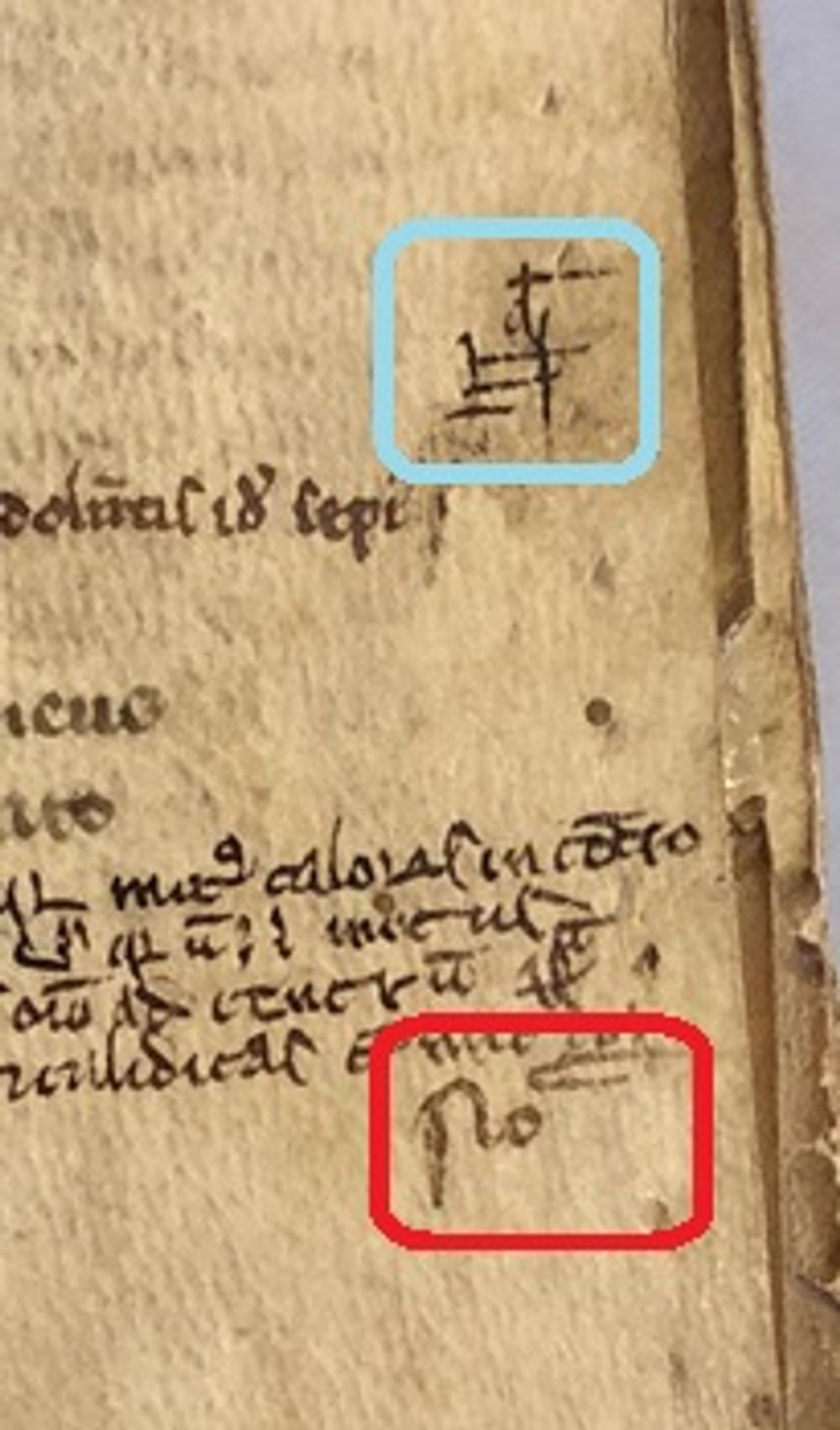
http://hdl.handle.net/1887.1/item:2356986

http://hdl.handle.net/1887.1/item:2356986
Here you see a selection of hands and other drawings calling attention to certain passages in the text.
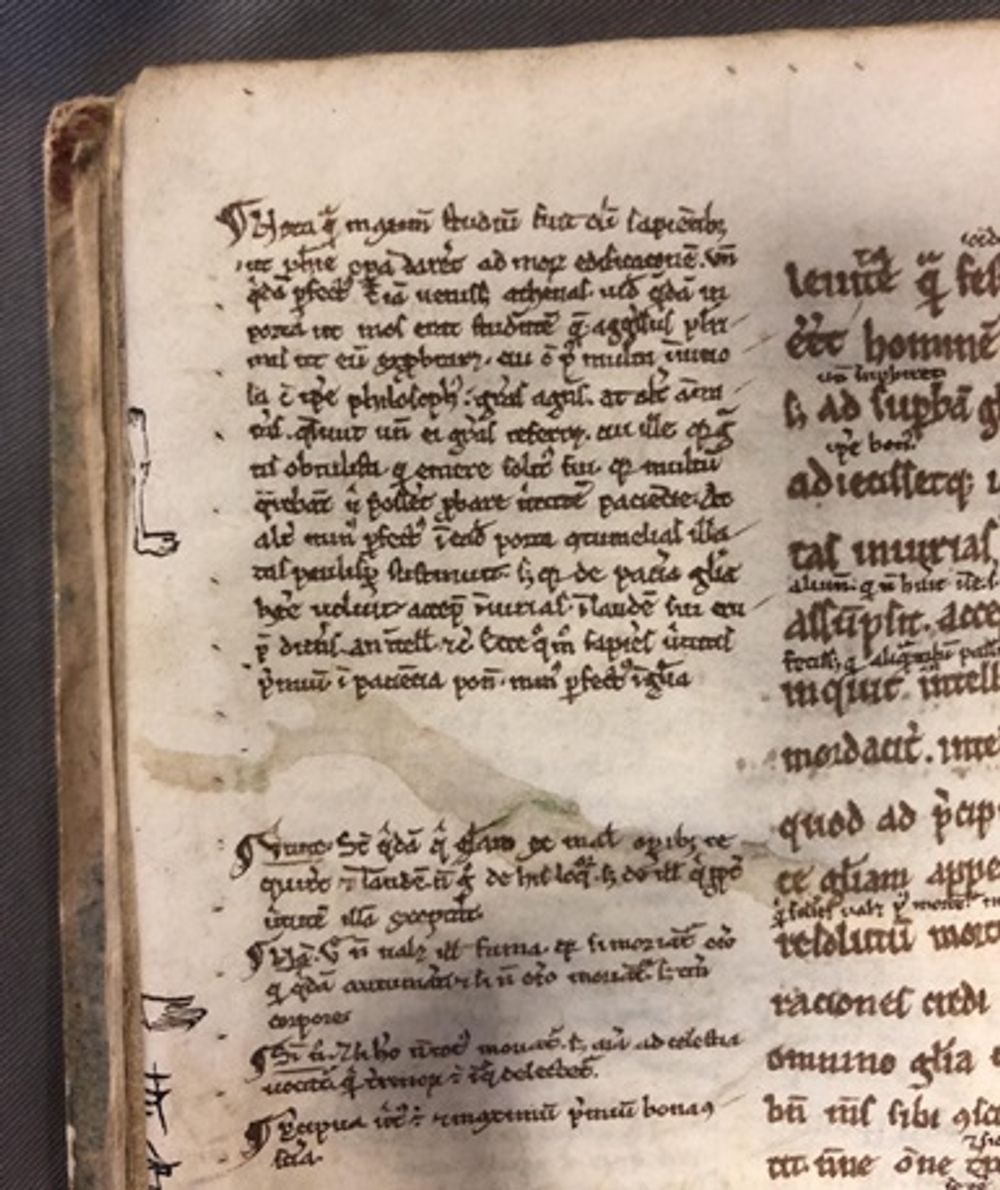

http://hdl.handle.net/1887.1/item:2356986
On this page (fol. 18r, lower right corner), two ‘talking heads’ are drawn, one of them wearing a ‘cappa’ or hat, the other not. Graduating from the medieval university involved a dress code: the new master was to wear a cappa, a certain cloak and certain shoes. So here, we could suggest that this drawing illustrates a master and a student talking. It portrays the process of reading, explaining and discussing a text together.
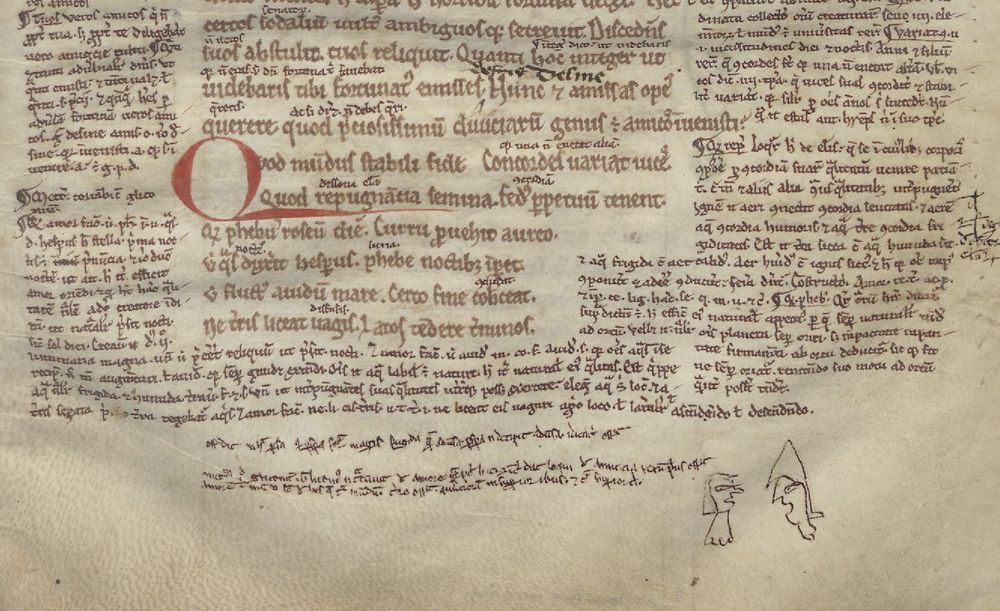
http://hdl.handle.net/1887.1/item:2356986
It is clear that the pages of this manuscript have been slightly cut along the edges of the pages. Some text and drawings are now incomplete. The cutting of pages was indeed common practice when a book was rebound. Yet even before the cutting, the placement of the faces, hands and other pointers was probably deliberately close to the edge of the page: when browsing through the manuscript, the marked passages would pop out immediately.


http://hdl.handle.net/1887.1/item:2356986
In the part of the book with Martianus Capella’s De nuptiis, the face of the page changes. Here (fol. 57v-58r) there was a large, existing commentary that was copied in the margin. There was hardly any space, so it seems, for other, more spontaneous material in the margins. The active and engaged look and feel of the annotated pages in the previous part shifts to a more passive one.


Boethius’ Consolation of Philosophy and Martianus’ De nuptiis do not have much in common concerning their contents, but their form is similar: they mix poetry and prose. That this was an important point of attraction for the readers is testified by many notes concerning the analysis of the poetic metres used by the authors. Here, on an added page (fol. 83r), a complete scheme of poetic metres has been drawn.

http://hdl.handle.net/1887.1/item:2356986
On occasion, later hands added other layers of notes to the text. Here (fol. 85v), for example, a hand added an extensive note in a very faded cursive hand, hardly legible anymore. Perhaps it is a draft of a new text, added in a space that was still empty. The writer used a dry pen or lead pencil.

http://hdl.handle.net/1887.1/item:2356986
The material state of this manuscript is not great. The text is executed with style and precision, but it was not written on top quality parchment. It was a functional book made for use and study, not for display. On fol. 21v, jagged page edges and a tear are visible.

http://hdl.handle.net/1887.1/item:2356986
Here (fol. 58r) you can see that the material was already damaged when the scribe was copying the commentary into the margins: he deals with the damaged parchment and the hole in it by writing around it.

http://hdl.handle.net/1887.1/item:2356986
At the very end of the book (ff. 93v-94r), a single page has been added (upside down) from a different manuscript: it is a page dated to around 1100 with a fragment from Macrobius’s commentary on Cicero’s Dream of Scipio. The page is a loose leaf. Although the combination could be entirely random, the theme of the two texts are similar: in Martianus the way in which the universe works is explained — how the planets revolve in their paths around the earth —, and in Macrobius too. That this was a point of interest for the thirteenth-century annotator is testified by tiny figures visualizing the different models of the movement of the planets through the cosmos (f. 90r).
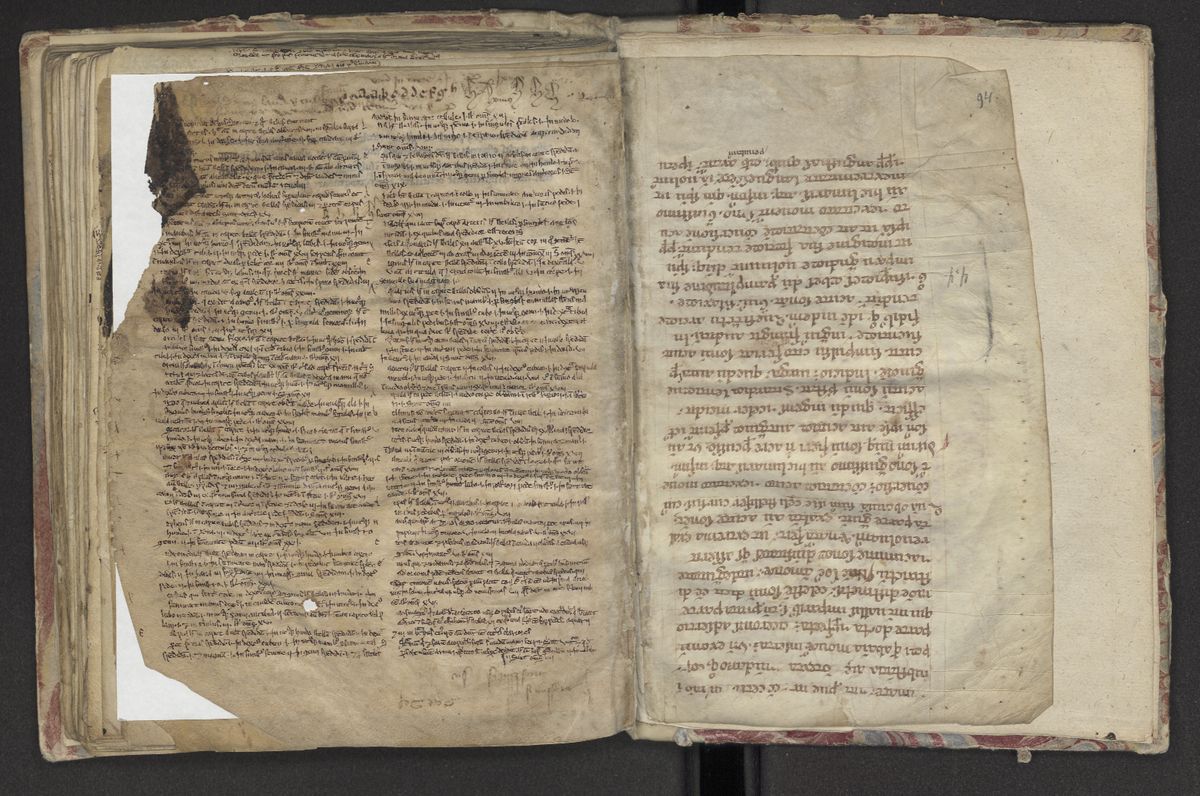

Sources used for this contribution:
- description and bibliography on Leiden, UB, Digital Collections website: http://hdl.handle.net/1887.1/item:2356986
- J. Peter Gumbert, Illustrated Inventory of Medieval Manuscripts, Vol. 2: Leiden, Universiteitsbibliotheek, BPL, Hilversum: Verloren, 2009, 01300-01301
- Mariken Teeuwen, “Practices of Appropriation: Writing in the Margin”, in Erik Kwakkel and Rodney Thomson (eds.), The European Book in the Twelfth Century, Cambridge University Press, 2018, 139-156
Contribution by Mariken Teeuwen.
Cite as, Mariken Teeuwen, “Leiden, UB, BPL 144”, The art of reasoning in medieval manuscripts (Dec 2020), https://art-of-reasoning.huygens.knaw.nl/bpl144. ↑


